| Back to the Future Part II (1989) | |
|---|---|
 | Rating: 7.8/10 (247,660 votes) Director: Robert Zemeckis Writer: Robert Zemeckis (characters), Bob Gale (characters), Robert Zemeckis (story), Bob Gale (story), Bob Gale (screenplay) Stars: Michael J. Fox, Christopher Lloyd, Lea Thompson, Thomas F. Wilson Runtime: 108 min Rated: PG Genre: Adventure, Comedy, Sci-Fi Released: 22 Nov 1989 |
| Plot: Marty McFly has only just gotten back from the past, when he is once again picked up by Dr. Emmett Brown and sent through time to the future. Marty's job in the future is to pose as his own son to prevent him from being thrown in prison. Unfortunately, things get worse when the future changes the present. | |
style="display:inline-block;width:320px;height:100px"
data-ad-client="ca-pub-7698183303596681"
data-ad-slot="5667385653">
Watch online from YouTube official page now.
There are still 291 days to go until Back to the Future day. On 21 October 2015 we will finally be at the point in time to which Marty McFly (Michael J Fox) travels in Back to the Future II, the 1989 sequel to the time-travelling classic.
The future he finds is one which has captured the imagination of millions – and one which has proved remarkably prescient. Save for a few key oversights (the internet, mobile phones) and a couple of over-hopeful punts in the dark (flying cars, hoverboards), the world dreamt up by writer Bob Gale and then brought to the screen by director Robert Zemeckis resembles our own in strange and uncanny ways. Here’s an A-Z guide to the gaps between that fictional world and our own, in the hope that inventors will spend the next 10 months wisely.
Automation
The film correctly anticipates an increased use of robot technology: petrol stations these days are pretty much computerised (albeit not suspended in space) and non-military drones – such as the one dispatched by USA Today in the film to take a photo – have recently experienced a surge in popularity.
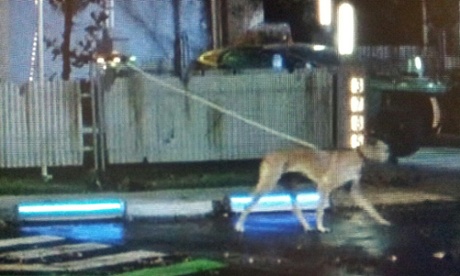
Yet the film overstates the pace: we don’t yet have remote-control litter bins or dog walkers, and waiters have not been replaced by TV screens (though automated supermarket checkouts have led to some redundancies).
Biometrics
The scanning of eyes and fingerprints is used in the film to check people’s identities, just as it is today. Yet the movie goes further, anticipating a widespread rollout of such technology to the domestic realm. The McFly’s home, for instance, comes with a scanner, rather than a doorknob.
Clothes
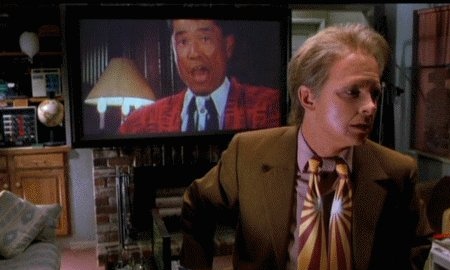
Perhaps the most glaring error made by the film-makers was in overestimating how much fashion might move forward. That said, it’s a relief that the double-tie fad hasn’t, in fact, taken off, nor the gold raincoat or sound effect-programmable vest (as sported by one of baddie Griff’s goons).
Marty’s size-adjustable, self-drying jacket has also not yet been manufactured, despite public appetite, though there have been advances in wicking technology.
Dust-repellant paper
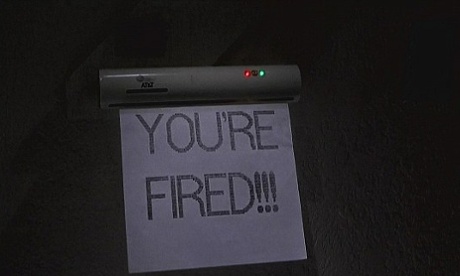
For all the innovation, the 2015 of Back to the Future Part II is still a print-heavy world, in which USA Today comes as a thick sheaf, faxes spew from machines in every room and the shop assistant in an antiques store casually mentions the invention of “dust-repellent paper”.
Eyewear
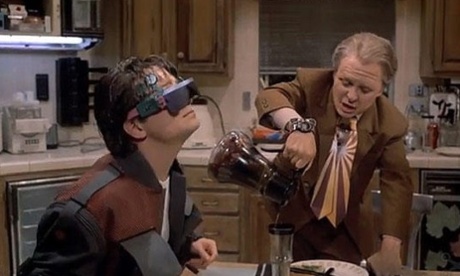
Almost everyone in the film at some point dons a pair of high-tech specs with remarkably Google Glass-style capabilities, such as cameras, magnification and access to some sort of unspecified database of information. They also have bluetooth-anticipating headsets.
Flying cars
One of the film’s most obvious errors. Yes, they do exist, but in nothing like the numbers choking the skies in the movie, and with nothing like the same manoeuvrability. Terrafugia unveiled a prototype several months ago, the Aeromobil 3.0, which they say could do more than 400 miles on one trip. But these are not currently on sale, and air traffic control plans have not been drafted.
Games consoles
We don’t see anyone playing a 2015 console, but their dominance – and hands-free nature – is hinted at by the scorn with which some kids from the future regard an old-style shooter game Marty plays in the nostalgia restaurant Cafe 80s.
Hoverboards
Ever since the film was released, a desperate market for these has existed. Yet problems, such as gravity, have meant that, while they’re in production, they are not yet available. A company called Hendo is working with Tony Hawk on a prototype. Interestingly, Hendo’s website doesn’t credit the movie for its inspiration, but rather their founder’s epiphany about “Magnetic Field Architecture™”.
Footage of Hawk shows a board not quite as sleek as that in the film. Whether it works on water (unlike Marty’s model) isn’t specified.
Internet
Notable by its absence. Yet the enormity of its impact only became apparent to the most plugged-in cyber-soothsayer in the mid-1990s.
Jaws 19
As some have pointed out, film-makers will need to get their skates on if multiplexes are to catch up with what Hill Valley is screening in October 2015 – Jaws 19, in 3D, directed by Max Spielberg.
They haven’t left much time to make ‘Jaws 5′ through to ‘Jaws 19’…
— edgarwright (@edgarwright) January 1, 2015
Yet we do indeed now live in a world of sequels and spin-offs, cinematic universes such as that conceived by Marvel, and prior brand awareness as a prerequisite for studio approval. Max, now 28, did not follow in his father’s footsteps, but 3D is everywhere, and today looks like a fixture rather than a fad.
Lawyers
Abolished in the future, leading to a much-accelerated justice system (and thereby handily oiling the wheels of the plot).
Mobility aids
An accident on the golf course has meant Marty’s father, George, has put his back out and must be propelled along upside down in some sort of hovering hoist. This barely looks helpful, so it’s little surprise it hasn’t yet been patented. Indeed its use in the film may be more crack-papering than creative – Crispin Glover, who played George in the first film, refused to return after a pay dispute, so the producers cast another actor in the role, swaddled him in prosthetics moulded from Glover’s face, then further promoted audience confusion by inverting him for the duration.
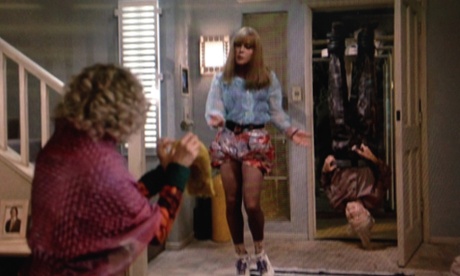
Clips involving Glover lifted from the first film were used in the second; the actor successfully sued over use of his image.
Nostalgia
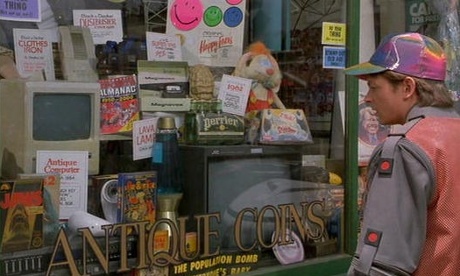
Marty must pay a visit to the Cafe 80s, and some of the questionable fashion choices of the residents of Hill Valley could be ascribed to a wave of 80s nostalgia which has not yet hit real-life 2015. That said, the collectibility of old tat from days past (a computer, a dust-buster) is accurate enough.
Old money
As with today, cash still exists as a currency – Marty’s inventor friend Doc hands him some notes with which he buys the Sports Almanac – despite a rise in alternative methods of payment.
Pizza
In the film, Marty’s mother, Lorraine, fixes supper for six by slipping a coaster-sized pizza into a Black and Decker rehydrator for a couple of seconds. Sadly, such a device has not yet come to pass and, indeed, although fast food is still popular, a move back towards slow cooking is also fashionable.
Quince
A retractable tray of fresh fruit and vegetables, positioned above the dining table, offers the family the opportunity to graze on greens. Despite the centrality of pizza in the future, people are still clearly eager for their five a day.
Rejuvenation clinic
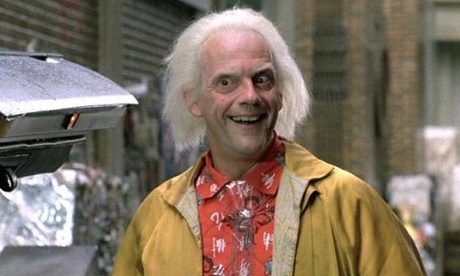
Botox feels like small-fry compared to the procedures that Doc reports having had at this place, including a full blood transfusion, hair repair and replacement of spleen and colon – with a resulting life-extension of around 40 years. Though elective cosmetic procedures are now common, such radical medical advances have not entered the mainstream.
Yet such a visit might also have been necessary so that Christopher Lloyd didn’t look too wrinkly for his romance with Mary Steenburgen in the third film, whose plot was conceived in tandem with Back to the Future Part II.
Self-tying shoelaces
These will, we’re promised with a Nike shoe designed Tinker Hatfield, be on sale later this year. Yet you’d be forgiven for remaining sceptical. In 2011 the company tried to cater for demand with the Nike Mag Air, which looked like Marty’s sneakers in the film … but with a bit of elastic where the power laces would have been.
TV
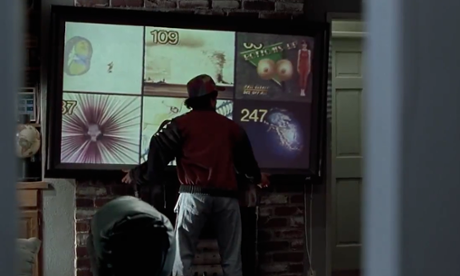
A big win for the movie here. Plasma flat-screens are everywhere in Back to the Future Part II, filling walls, popping up as billboards and on window blinds. As well as anticipating such a change in hardware, Gale also rightly assumes that TV watching will remain a popular hobby for teenagers, and that a multi-screen experience will be the norm (in this case, as a grid of six different channels at once).
Urban regeneration
Even in the “good” version of 1985, Hill Valley’s town centre is decaying and litter-strewn, a shadow of its 1955 heyday. Yet in 2015, it’s back to its spick-and-span best, while Hilldale, the 80s-built yuppie suburb, has become trashy and even dangerous. A move towards sprucing up town centres is one of the movie’s more surprisingly accurate predictions.
Video calls
They may not have forseen the internet, but Gale and co cooked up something remarkably close to Skype with their AT&T-powered flat-screen video calls. In the film, these come with rolling info about the caller – names of children, hobbies, food preferences – which scrolls along the bottom of the screen. Social media means such personal information is redundant, but its inclusion here does provide a weird premonition of Facebook.
Weather reports
These are accurate to the second in the movie, whereas meteorological advances in real life have been much more halting. There is no indication that the rain storm they drive through at the start of the film is part of the spate of extreme weather we experience today.
X-ray vision
Griff doesn’t quite have this yet, but that’s because his “bionic implants are short-circuiting” – another example of elective medical procedures which further turn humans into machines.
Yello?
Other than the internet, the advent of the mobile phone is the movie’s other big miss – curious, given that they were already in (bricklike) use in 1989. Functioning phone boxes are a common sight on the streets of Hill Valley. These days they’re either converted into wifi hubs or have become ad hoc urinals.
Zappers
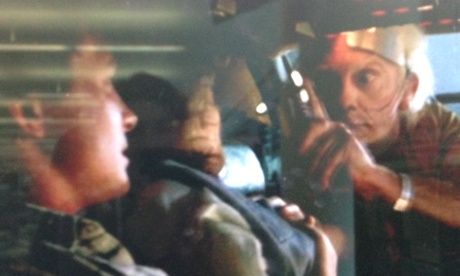
In Back to the Future Part II, zapper gadgets are available which can render someone safely unconscious for an hour. Doc seems a devoted user, administering doses to Marty’s girlfriend, Jennifer, and their son, Marty Jr, as well as putting his dog, Einstein, in a “suspended animation kennel”. The ethics of such tech are not discussed.
guardian.co.uk © Guardian News & Media Limited 2010
Published via the Guardian News Feed plugin for WordPress.
What Back to the Future Part II got right and wrong about 2015-Watch Movie Now











0 comments:
Post a Comment